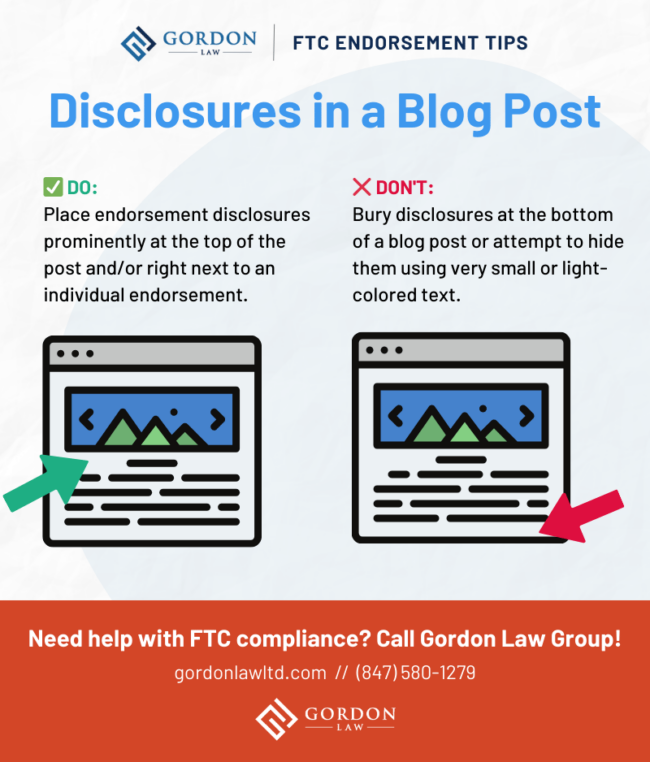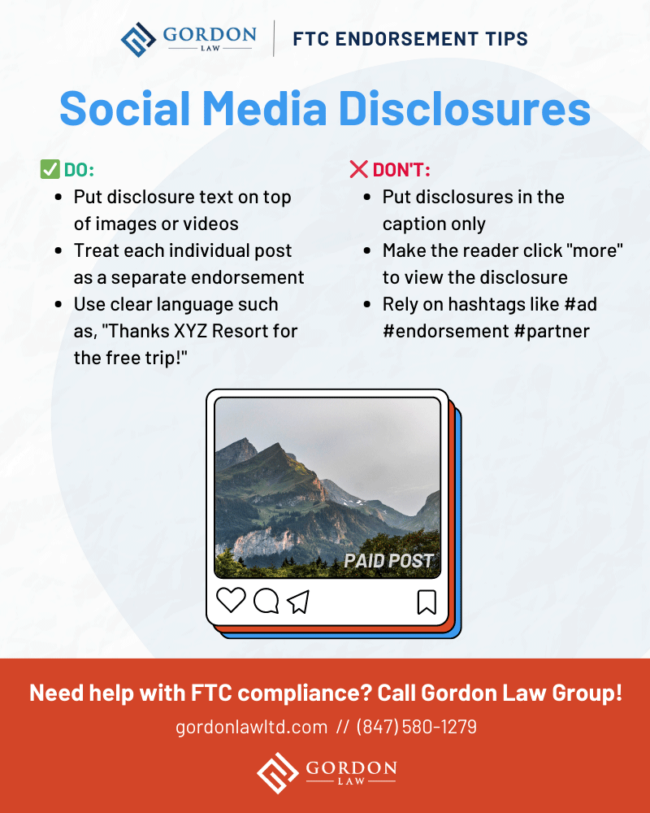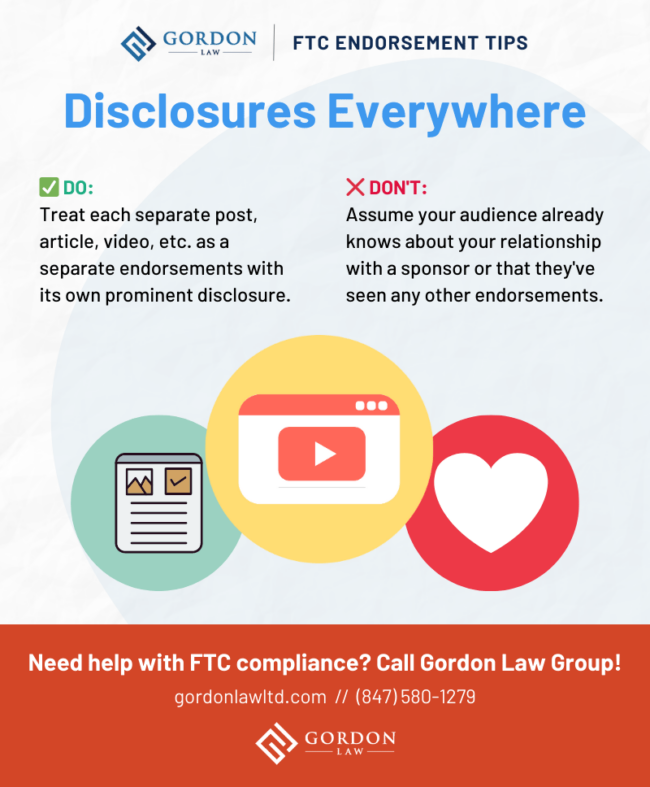As a business owner, content creator, or affiliate marketer, following the Federal Trade Commission (FTC) endorsement guidelines is paramount for building consumer trust and avoiding legal pitfalls.
The FTC recently released revised endorsement guidelines, along with an in-depth Q&A, to provide clearer instructions on endorsement practices and sponsored content. In this blog post, our FTC attorneys—who have more than 10 years of experience preventing and resolving FTC problems—explain the key takeaways from these updated guidelines.
We highly recommend that you read the FTC’s guidelines and Q&A in full, but here are some of the most important things you need to know:
1. Clearly and Conspicuously Disclose Material Connections
To comply with the FTC guidelines, any material connection between an endorser and a business must be disclosed “clearly and conspicuously.” This means that the disclosure should be noticeable and easily understood by consumers. Avoid burying disclosures in lengthy paragraphs or using ambiguous language that may confuse readers.
For example, if you have a blog post that contains affiliate links, the FTC says it’s not enough to have a disclosure at the bottom of the blog post; the endorsement and the disclosure should ideally be visible at the same time. According to the FTC’s Q&A, “The closer the disclosure is to your recommendation, the better.”
The FTC also provides many examples for adding disclosures to videos and social media posts—more on that below.
2. Paid Social Media Posts Require Obvious, “Unavoidable” Disclosures
The FTC stresses the need for disclosures to be readily visible and easily understandable to consumers, including on all types of social media posts.
The language must be clear and the user should be able to easily notice the disclosure without having to take extra steps. The FTC also clarified that it’s not always enough to rely on a platform’s built-in disclosure tools, such as Instagram’s paid partnership posts.
Here are some examples of how to achieve visibility on various social media platforms:
- Captions and Hashtags: The FTC notes that hashtags such as #ambassador, #comped, #endorsement, or #partner are not sufficient disclosures. Instead, it recommends making a clear disclosure statement, such as, “Thanks to XYZ Resort for the free trip.”
- Instagram Posts: Disclosures in the caption must be placed above the “more” button, ensuring that consumers see the disclosure without having to click to expand the post. Avoid burying the disclosure in a sea of hashtags or lengthy captions, as this may diminish its visibility and effectiveness. “You might need a disclosure superimposed over the picture,” according to the FTC’s Q&A.
- Instagram Stories: If using Instagram Stories for endorsements, the disclosure should be superimposed on the image or video, ensuring it appears on screen for a sufficient duration to be noticed and read by viewers.
- TikTok: In the fast-paced world of TikTok, it’s essential to make disclosures immediately noticeable. Placing the disclosure in the video itself or as a large text overlay at the beginning of the video ensures viewers are aware of the material connection right from the start.
- YouTube Videos: For video content, disclosures should be made both audibly and visually at the beginning of the video, ensuring that viewers are informed before they get deep into the content. For longer videos, another disclosure may be needed just before the product endorsement. Additionally, including the disclosure in the video description is not sufficient on its own; the disclosure should also appear within the video itself.
- Twitter: Due to character limitations, Twitter endorsements may be challenging. However, it’s still essential to include a clear disclosure within the tweet itself, avoiding obscure abbreviations or acronyms that could be easily misunderstood.
Remember, the goal is to ensure that consumers can easily spot the disclosure without having to take additional steps or search for it. By adopting these practices, you can create a seamless and transparent experience for your audience, bolstering consumer trust and complying with the FTC’s endorsement guidelines.
3. Be Specific About Your Compensation and its Source
When disclosing a material connection, provide accurate information about the compensation received and its source. Here are some examples that the FTC considers incomplete and deceptive:
- If you receive a free product to review and you also earn commission via an affiliate link for that product, it’s not enough to say that you received the product for free. All forms of compensation must be disclosed.
- If you receive one gift card to give away in a contest and another gift card for yourself, it’s not enough to say you received a gift card to give away.
- If you’re hired by an affiliate network called BrandX to review a video game by BrandZ, failing to disclose the relationship to BrandZ in your review could be considered deceptive—even if they’re not technically the ones paying you.
That being said, you don’t need to disclose exactly how much you’re getting paid. According to the FTC, “What matters is whether the information would have an effect on the weight readers would give your review. So, whether you got $100 or $1,000, you could simply say you were ‘paid.’ (That wouldn’t be good enough, however, if you’re an employee or co-owner.)”
4. Affiliate Marketing Links Must Convey Material Connections
When using affiliate marketing links, clearly disclose the material connection to consumers. While wording such as “paid link” is sufficient, saying “affiliate link” or “commissionable link” may not be as effective since consumers might not grasp the meaning. For instance:
- Compliant: “This is a paid link that supports my channel.”
- Non-Compliant: “Here’s my commissionable link to Product Z.”
5. Each Piece of Content Must Have its Own Disclosure
If endorsements appear within multiple advertisements, each ad must contain its own disclosure. For example, if you’re a travel influencer who receives a free stay at a hotel in exchange for promoting the business, you might publish several endorsement posts throughout your trip. In this case, each post should be treated as a separate advertisement with its own clear and conspicuous disclosure.
According the Q&A published by the FTC, “An influencer can’t assume that followers will read more than one of their posts and associate them with each other.”
6. Endorsements Must Reflect Accurate Consumer Experiences
Endorsers must provide genuine opinions and experiences. They cannot make false claims or misrepresent their actual experience with the product or service. For example, endorsers cannot claim results that they haven’t personally experienced.
The FTC also warns brands against highlighting specific customer experiences that aren’t typical. If a brand does highlight an above-average example, there should be a prominent disclosure stating the typical results.
7. Employees, Family, and Friends Must Disclose Material Connections
If an employee, family member, or friend endorses a product or service, they must disclose any material connection they have with the business. Their endorsement cannot mislead consumers into thinking they are unbiased when, in fact, they have a vested interest in the success of the product or service.
Learn more about common mistakes with gathering online reviews for your business.
8. Brands are Responsible for Their Influencers, Networks, and Agencies
Brands should actively monitor the activities of influencers, advertising networks, and agencies they work with to ensure compliance with the FTC guidelines. Brands can be held accountable for non-compliant endorsements made on their behalf.
To ensure your endorsement practices align with the FTC guidelines, adopt a proactive and transparent approach.
In addition to including clauses about FTC compliance in your affiliate agreements, you should actively monitor your affiliates’ statements and craft an internal policy for addressing noncompliant materials. Strong compliance policies can be very beneficial in case you become the subject of an FTC investigation or complaint.
Learn more about how to respond to an FTC subpoena.
Need Help with FTC Compliance?
At Gordon Law Group, we understand the challenges faced by businesses and influencers in complying with FTC regulations. With over a decade of experience, our team of FTC attorneys can review your marketing materials for compliance with marketing regulations; draft strong affiliate marketing agreements; and design company policies and internal controls to protect you even further. We also offer a full suite of legal and tax services for affiliate marketers and ecommerce businesses.
Don’t hesitate to reach out if you need help with FTC compliance or other marketing regulations!







